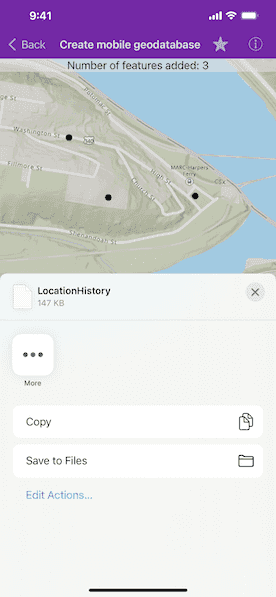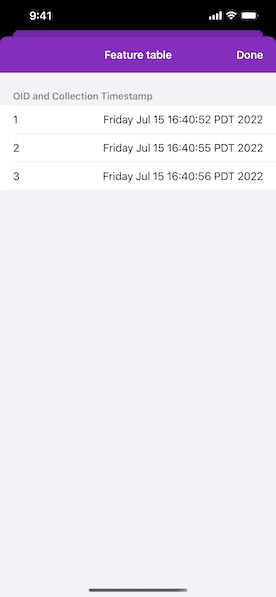Create and share a mobile geodatabase.


Use case
A mobile geodatabase is a collection of various types of GIS datasets contained in a single file (.geodatabase) on disk that can store, query, and manage spatial and nonspatial data. Mobile geodatabases are stored in a SQLite database and can contain up to 2 TB of portable data. Users can create, edit and share mobile geodatabases across ArcGIS Pro, ArcGIS Runtime, or any SQL software. These mobile geodatabases support both viewing and editing and enable new offline editing workflows that don't require a feature service.
For example, a user would like to track the location of their device at various intervals to generate a heat map of the most visited locations. The user can add each location as a feature to a table and generate a mobile geodatabase. The user can then instantly share the mobile geodatabase to ArcGIS Pro to generate a heat map using the recorded locations stored as a geodatabase feature table.
How to use the sample
Tap on the map to add a feature symbolizing the user's location. Tap "View table" to view the contents of the geodatabase feature table. Once you have added the location points to the map, tap on "Create and share" to retrieve the .geodatabase file which can then be imported into ArcGIS Pro or opened in an ArcGIS Runtime application.
How it works
- Create the
AGSGeodatabasefrom the mobile geodatabase location on file. - Create a new
AGSTableDescriptionand add the list ofAGSFieldDescriptions to the table description. - Create an
AGSGeodatabaseFeatureTablein the geodatabase from theAGSTableDescriptionusingAGSGeodatabase.createTable(with:completion:). - Create a feature on the selected map point using
AGSGeodatabaseFeatureTable.createFeature(attributes:geometry:). - Add the feature to the table using
AGSGeodatabaseFeatureTable.add(_:completion:). - Each feature added to the
AGSGeodatabaseFeatureTableis committed to the mobile geodatabase file. - Close the mobile geodatabase to safely share the
.geodatabasefile usingAGSGeodatabase.close()
Relevant API
- AGSArcGISFeature
- AGSFeatureLayer
- AGSFeatureTable
- AGSFieldDescription
- AGSGeodatabase
- AGSGeodatabaseFeatureTable
- AGSTableDescription
Additional information
Learn more about mobile geodatabases and how to utilize them on the ArcGIS Pro documentation page. The following mobile geodatabase behaviors are supported in ArcGIS Runtime: annotation, attachments, attribute rules, contingent values, dimensions, domains, feature-linked annotation, subtypes, utility network and relationship classes.
Learn more about the types of fields supported with mobile geodatabases on the ArcGIS Pro documentation page.
Tags
arcgis pro, database, feature, feature table, geodatabase, mobile geodatabase, sqlite
Sample Code
// Copyright 2022 Esri.
//
// Licensed under the Apache License, Version 2.0 (the "License");
// you may not use this file except in compliance with the License.
// You may obtain a copy of the License at
//
// http://www.apache.org/licenses/LICENSE-2.0
//
// Unless required by applicable law or agreed to in writing, software
// distributed under the License is distributed on an "AS IS" BASIS,
// WITHOUT WARRANTIES OR CONDITIONS OF ANY KIND, either express or implied.
// See the License for the specific language governing permissions and
// limitations under the License.
import UIKit
import ArcGIS
class CreateMobileGeodatabaseViewController: UIViewController {
@IBOutlet var mapView: AGSMapView! {
didSet {
// Create a map with the topographic basemap.
mapView.map = AGSMap(basemapStyle: .arcGISTopographic)
// Set the viewpoint.
mapView.setViewpoint(AGSViewpoint(latitude: 39.323845, longitude: -77.733201, scale: 10_000))
// Set the touch delegate.
mapView.touchDelegate = self
}
}
@IBOutlet var viewTableBarButtonItem: UIBarButtonItem!
@IBOutlet var createShareBarButtonItem: UIBarButtonItem!
@IBOutlet var featureCountLabel: UILabel!
/// A URL to the temporary geodatabase.
let temporaryGeodatabaseURL: URL
/// A directory to temporarily store the geodatabase.
let temporaryDirectory: URL
/// The mobile geodatabase.
var geodatabase: AGSGeodatabase?
/// The feature table created along with the geodatabase.
var featureTable: AGSGeodatabaseFeatureTable?
required init?(coder: NSCoder) {
// Create the temporary directory.
temporaryDirectory = FileManager.default.temporaryDirectory.appendingPathComponent(ProcessInfo().globallyUniqueString)
try? FileManager.default.createDirectory(at: temporaryDirectory, withIntermediateDirectories: false)
// Create the geodatabase path.
temporaryGeodatabaseURL = temporaryDirectory
.appendingPathComponent("LocationHistory", isDirectory: false)
.appendingPathExtension("geodatabase")
super.init(coder: coder)
}
// MARK: Methods
/// Prompt options to share the geodatabase.
@IBAction func closeAndShare(_ sender: UIBarButtonItem) {
// Create the activity view controller with the geodatabase URL.
let activityViewController = UIActivityViewController(activityItems: [temporaryGeodatabaseURL], applicationActivities: nil)
// Set the popover presentation.
activityViewController.popoverPresentationController?.barButtonItem = sender
// Present the activity view controller.
present(activityViewController, animated: true)
// Reset the map's state once the geodatabase has been shared.
activityViewController.completionWithItemsHandler = { [weak self] _, completed, _, activityError in
if completed {
self?.resetMap()
} else if let error = activityError {
self?.presentAlert(error: error)
}
}
}
/// Query features when the "View table" button is tapped.
@IBAction func queryFeatures() {
guard let featureTable = featureTable else { return }
let navigationController = storyboard!.instantiateViewController(withIdentifier: "NavigationController") as! UINavigationController
let mobileGeodatabaseController = navigationController.viewControllers.first as! MobileGeodatabaseTableViewController
featureTable.queryFeatures(with: AGSQueryParameters()) { [weak self] results, error in
guard let self = self else { return }
if let results = results {
let features = results.featureEnumerator().allObjects
// Create an array of each feature's OID.
mobileGeodatabaseController.oidArray = features.compactMap { $0.attributes["oid"] as? Int }
// Create an array of each feature's time stamps.
mobileGeodatabaseController.collectionTimeStamps = features.compactMap { $0.attributes["collection_timestamp"] as? Date }
self.present(navigationController, animated: true)
} else if let error = error {
self.presentAlert(error: error)
}
}
}
// Create the mobile geodatabase.
func createGeodatabase() {
// Remove the file if it already exists.
if FileManager.default.fileExists(atPath: temporaryGeodatabaseURL.path) {
do {
try FileManager.default.removeItem(at: temporaryGeodatabaseURL)
} catch {
presentAlert(title: "File already exists")
}
}
// Create the mobile geodatabase at the given URL.
AGSGeodatabase.create(withFileURL: temporaryGeodatabaseURL) { [weak self] result, error in
guard let self = self else { return }
self.geodatabase = result
// Add a new table to the geodatabase by creating one from the table description.
self.geodatabase?.createTable(with: self.makeTableDescription()) { table, error in
if let table = table {
// Load the table.
table.load { _ in
self.featureTable = table
// Create a feature layer using the table.
let featureLayer = AGSFeatureLayer(featureTable: table)
// Add the feature layer to the map's operational layers.
self.mapView.map?.operationalLayers.add(featureLayer)
self.featureCountLabel.text = "Number of features added: 0"
}
} else if let error = error {
self.presentAlert(error: error)
}
}
}
}
/// Make an `AGSTableDescription` for the geodatabase.
func makeTableDescription() -> AGSTableDescription {
// Create a description for the feature table.
let tableDescription = AGSTableDescription(name: "LocationHistory", spatialReference: .wgs84(), geometryType: .point)
// Create and add the description fields for the table.z
// `AGSFieldType.OID` is the primary key of the SQLite table.
// `AGSFieldType.DATE` is a date column used to store a Calendar date.
// `AGSFieldDescription`s can be a SHORT, INTEGER, GUID, FLOAT, DOUBLE, DATE, TEXT, OID, GLOBALID, BLOB, GEOMETRY, RASTER, or XML.
let fieldDescriptions = [
AGSFieldDescription(name: "oid", fieldType: .OID),
AGSFieldDescription(name: "collection_timestamp", fieldType: .date)
]
tableDescription.fieldDescriptions.addObjects(from: fieldDescriptions)
// Set any unnecessary properties to false.
tableDescription.hasAttachments = false
tableDescription.hasM = false
tableDescription.hasZ = false
return tableDescription
}
/// Add a feature at the provided map point.
func addFeature(at mapPoint: AGSPoint) {
guard let featureTable = featureTable else { return }
// Create an attribute with the current date.
let attributes = ["collection_timestamp": Date()]
// Create a feature with the created attribute and geometry.
let feature = featureTable.createFeature(attributes: attributes, geometry: mapPoint)
// Add the feature to the feature table.
featureTable.add(feature) { [weak self] error in
guard let self = self else { return }
if let error = error {
self.presentAlert(error: error)
} else {
let featureCount = String(featureTable.numberOfFeatures)
// Update the label's text to display the current number of features.
self.featureCountLabel.text = String(format: "Number of features added: %@", featureCount)
// Enable the view table bar button item.
self.viewTableBarButtonItem.isEnabled = true
}
}
}
/// Remove existing operational layers and close the geodatabase.
func resetMap() {
if let geodatabase = geodatabase {
// Close the geodatabase to cease all adjustments.
geodatabase.close()
// Remove the current feature layers.
mapView.map?.operationalLayers.removeAllObjects()
// Reset the button's state.
viewTableBarButtonItem.isEnabled = false
// Create a new mobile geodatabase.
createGeodatabase()
}
}
deinit {
try? FileManager.default.removeItem(at: temporaryDirectory)
}
// MARK: UIViewController
override func viewDidLoad() {
super.viewDidLoad()
// Create the initial geodatabase.
createGeodatabase()
// Add the source code button item to the right of navigation bar.
(navigationItem.rightBarButtonItem as? SourceCodeBarButtonItem)?.filenames = [
"CreateMobileGeodatabaseViewController",
"MobileGeodatabaseTableViewController"
]
}
}
// MARK: - AGSGeoViewTouchDelegate
extension CreateMobileGeodatabaseViewController: AGSGeoViewTouchDelegate {
func geoView(_ geoView: AGSGeoView, didTapAtScreenPoint screenPoint: CGPoint, mapPoint: AGSPoint) {
addFeature(at: mapPoint)
}
}